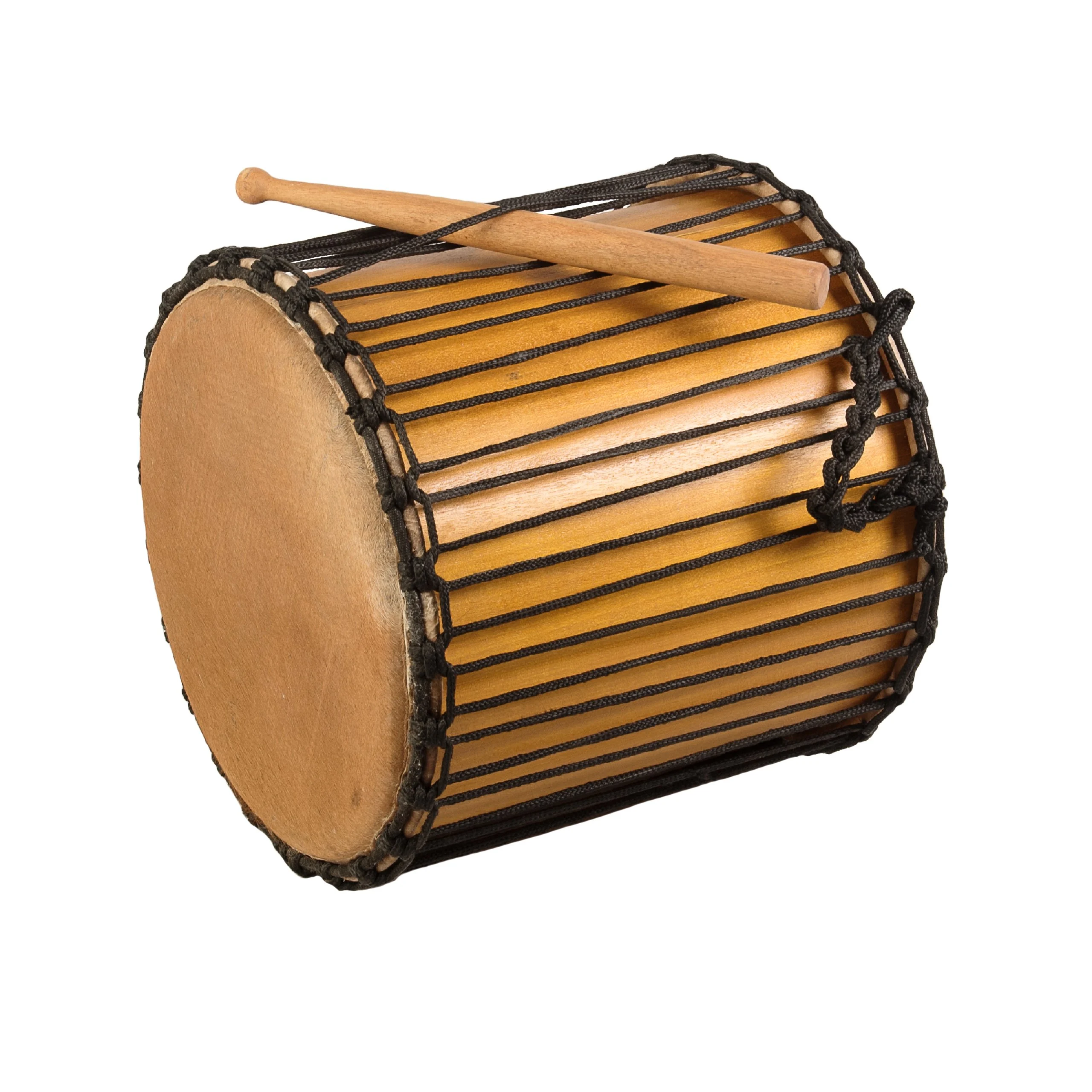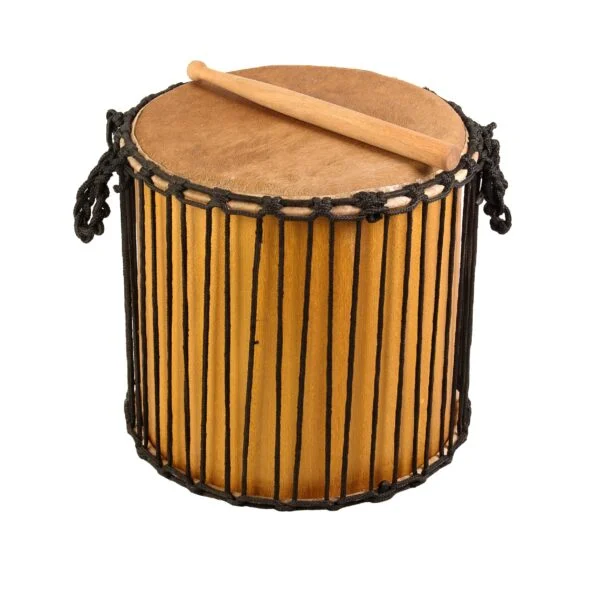Kenkeni
Percussions
Africa
Between 1001 and 1900 AD
Video
The kenkeni is a traditional West African musical instrument, classified as a member of the dunun family of drums. It is recognized for its distinct sound and role within the ensemble of Mande music. The kenkeni is the smallest of the dunun drums, typically measuring between 45 to 50 cm in length and 25 to 35 cm in diameter. It features a cylindrical shape, constructed with rawhide skins stretched over both ends, which are secured by ropes along the sides. This design allows for tuning adjustments, enabling players to achieve the desired pitch.
As a membranophone, the kenkeni produces sound primarily through the vibration of its drumheads when struck. It falls under the Hornbostel-Sachs classification 211.212.1, which categorizes it as a directly struck membranophone with two usable membranes. The instrument is played using a mallet, and its high pitch distinguishes it from its larger counterparts, the sangban and dundunba.
History
The history of the Kenkeni traces back to the heart of West Africa, where it has been an integral part of the region’s music for centuries. The exact origin of the Kenkeni is not definitively recorded, but it is believed to have emerged in the 17th century within the Mandé-speaking communities. The Mandé people, who reside primarily in the Sahel and the savannah regions of West Africa, are known for their sophisticated musical traditions, and the Kenkeni is one of the cornerstones of these practices.
The Kenkeni, like other talking drums, was originally used to communicate messages over long distances. The tonal variations of the drum are capable of mimicking the pitch and rhythm of the spoken word, which is crucial for transmitting information in a society with limited written communication. Additionally, the drum was used in ceremonial and religious settings, where it accompanied dances, chants, and rituals, playing a role in connecting the physical and spiritual realms. As African societies encountered colonialism and the global spread of musical traditions, the Kenkeni, along with other traditional instruments, faced challenges of preservation. However, its enduring importance in local communities has led to its revival and continued use, not only in Africa but also in various parts of the world, as interest in world music and African culture has grown.
Construction
The construction of a kenkeni involves careful craftsmanship. Typically made from hardwood for the body and animal skin for the drumheads, artisans ensure that both materials are of high quality to produce a vibrant sound. The drum’s cylindrical shape is achieved through skilled woodworking techniques, and the tuning process involves adjusting the tension of the ropes that hold the skin in place. This construction method not only affects sound quality but also contributes to the instrument’s durability.
Types
Within the dunun family, there are three primary types:
Kenkeni: The smallest drum with the highest pitch.
Sangban: A medium-sized drum that produces a mid-range pitch.
Dundunba: The largest drum with the lowest pitch.
Each type plays a unique role in ensemble performances, contributing to a layered rhythmic texture that characterizes Mande music.
Features
The Kenkeni’s most striking feature is its ability to mimic the intonations of human speech, making it a “talking drum.” This tonal flexibility is achieved through the use of tension ropes or cords, which alter the drum’s pitch as the player squeezes or loosens them. The drum’s ability to change pitch rapidly allows for the reproduction of various sounds, making it highly versatile and expressive. It is typically played with the hands, although in some regions, sticks or mallets may be used. The sound production of the Kenkeni is notably sharp and clear, with a range that can evoke both powerful percussive rhythms and subtle, delicate tones. The distinct sound of the Kenkeni makes it an important tool for creating complex rhythms in West African music, whether it be for communicating messages or simply for musical performance.
Sound Production
Sound production on the kenkeni occurs when a player strikes one of its heads with a mallet. The tension of the drumhead influences pitch; tighter skins produce higher notes while looser skins yield lower tones. The interplay between different dununs creates a rich tapestry of sound that supports melodic lines played on other instruments like the djembe. Additionally, players can create variations in dynamics and accents by altering their striking technique.
Playing Methods
The Kenkeni is traditionally played with the hands, although some players use sticks or mallets in certain situations. The hand techniques used for the Kenkeni vary based on the specific rhythms being played, but they generally involve both open-handed slaps and finger strikes. The player may also use the palm for deeper, bass-like sounds and the fingertips for higher-pitched sounds. The manipulation of the tension cords with the left hand is often done simultaneously, allowing the player to create pitch bends and other expressive sounds that mimic human speech.
The Kenkeni player must be skilled in controlling the pitch of the instrument through the squeezing and releasing of the tension cords, which requires dexterity and precise timing. This ability to mimic human speech is what makes the Kenkeni such a unique and powerful instrument. In many cultures, the drum is seen as a means of communication, and players are highly respected for their ability to “speak” through their rhythms.
Roles in Music
The Kenkeni plays several key roles in traditional West African music. One of its primary functions is to serve as a communication tool, both in practical and ceremonial contexts. Historically, the Kenkeni was used to deliver messages over long distances, with its ability to mimic speech making it an ideal instrument for conveying information. In more modern contexts, the Kenkeni is used in festivals, celebrations, and public events, where its expressive sound adds a powerful emotional layer to the music. In addition to its role in communication, the Kenkeni is also an essential component of African drumming ensembles. It is often paired with other drums, such as the Djembe or the Tama, to create intricate rhythms that form the foundation of many musical performances. The Kenkeni’s sharp and high-pitched sound contrasts beautifully with the deeper tones of larger drums, allowing it to stand out in a percussion ensemble.
The instrument also plays a crucial role in African dance, where its rhythms guide the movements of dancers. In some West African rituals, the Kenkeni is believed to communicate with ancestral spirits, and it is used in religious ceremonies to invoke divine presence and blessings. The drum’s ability to convey emotions and connect people with the spiritual realm is one of the reasons it holds such an esteemed place in African culture.
FAQ
What kind of sound does the Kenkeni produce?
The Kenkeni produces a sharp, high-pitched sound that is distinct and vibrant. Its tone is clear and often used to accentuate rhythms in traditional African music. The sound is crisp and percussive, resonating through its wooden body and metal components. It is commonly used to add emphasis and energy to musical ensembles.
What are the primary uses of the Kenkeni musical instrument?
The Kenkeni is typically used in traditional African music, especially in West African cultures. It plays a key role in drumming ensembles, accompanying dances and rituals. It is used for marking time, maintaining rhythm, and complementing other instruments. It also serves as a communication tool in some cultures, signaling messages or events.
What types of Kenkeni exist?
There are various types of Kenkeni, each designed for specific cultural and musical contexts. Some are larger and produce deeper tones, while others are smaller and sharper. The material construction can also vary, with some Kenkenis made from wood, while others feature metal elements. Different regions may have variations in design and sound depending on local traditions.
 Links
Links
References
Other Instrument
Categories



















